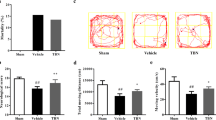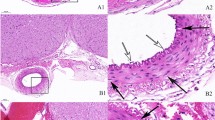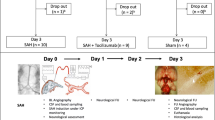Abstract
We investigated the efficacy of the ferrous iron (Fe2+) chelator 2,2′-dipyridyl (DP) to attenuate cerebral vasospasm after subarachnoid hemorrhage (SAH). Thirty-six New Zealand white rabbits were randomly assigned to four groups: untreated control, SAH, SAH + dimethyl sulfoxide (DMSO) vehicle, and SAH + DP. SAH was induced by injection of autologous blood into the cisterna magna and then DP or vehicle was infused into the cistern magna for 5 days (20 mg/kg/day or an equal volume of DMSO). Neurological deficit score (NDS) was used to assess neurological function and cerebral angiography to measure basilar artery (BA) diameter following SAH. TUNEL staining was used to detect BA endothelial cell apoptosis, and immunohistochemistry and Western blotting to assess changes in caspase-3 protein levels 5 days post-SAH. The SAH + DP group had a significantly larger mean BA diameter and lower mean NDS post-SAH compared to the SAH + DMSO and SAH groups (p < 0.05). TUNEL-positive cell numbers and caspase-3 levels were significantly reduced in BA endothelial cells of the SAH + DP group as compared to the SAH and SAH + DMSO groups (p < 0.05). The iron chelator DP reduced vasospasm and neurological sequelae in rabbits, likely by chelating the Fe2+ in oxyhemoglobin and reducing oxidative stress-induced endothelial cell apoptosis.




Similar content being viewed by others
References
van Gijn J, Rinkel GJ (2001) Subarachnoid haemorrhage: diagnosis, causes and management. Brain 124:249–278
van Gijn J, Kerr RS, Rinkel GJ (2007) Subarachnoid haemorrhage. Lancet 369:306–318
Harrod CG, Bendok BR, Batjer HH (2005) Prediction of cerebral vasospasm in patients presenting with aneurysmal subarachnoid hemorrhage: a review. Neurosurgery 56:633–654 (discussion 633–654)
Tseng MY, Czosnyka M, Richards H, Pickard JD, Kirkpatrick PJ (2005) Effects of acute treatment with pravastatin on cerebral vasospasm, autoregulation, and delayed ischemic deficits after aneurysmal subarachnoid hemorrhage: a phase II randomized placebo-controlled trial. Stroke 36:1627–1632
Arthur AS, Fergus AH, Lanzino G, Mathys J, Kassell NF, Lee KS (1997) Systemic administration of the iron chelator deferiprone attenuates subarachnoid hemorrhage-induced cerebral vasospasm in the rabbit. Neurosurgery 41:1385–1391 (discussion 1391–1382)
Pluta RM, Afshar JK, Boock RJ, Oldfield EH (1998) Temporal changes in perivascular concentrations of oxyhemoglobin, deoxyhemoglobin, and methemoglobin after subarachnoid hemorrhage. J Neurosurg 88:557–561
Asano T (1999) Oxyhemoglobin as the principal cause of cerebral vasospasm: a holistic view of its actions. Crit Rev Neurosurg 9:303–318
Macdonald RL, Weir BK (1991) A review of hemoglobin and the pathogenesis of cerebral vasospasm. Stroke 22:971–982
Pluta RM, Oldfield EH (2007) Analysis of nitric oxide (NO) in cerebral vasospasm after aneursymal bleeding. Rev Recent Clin Trials 2:59–67
Sano K, Asano T, Tanishima T, Sasaki T (1980) Lipid peroxidation as a cause of cerebral vasospasm. Neurol Res 2:253–272
Ayer RE, Zhang JH (2008) Oxidative stress in subarachnoid haemorrhage: significance in acute brain injury and vasospasm. Acta Neurochir Suppl 104:33–41
Berra LV, Carcereri De Prati A, Suzuki H, Pasqualin A (2007) The role of constitutive and inducible nitric oxide synthase in the human brain after subarachnoid hemorrhage. J Neurosurg Sci 51:1–9
Horky LL, Pluta RM, Boock RJ, Oldfield EH (1998) Role of ferrous iron chelator 2,2′-dipyridyl in preventing delayed vasospasm in a primate model of subarachnoid hemorrhage. J Neurosurg 88:298–303
Zubkov AY, Tibbs RE, Clower B, Ogihara K, Aoki K, Zhang JH (2002) Morphological changes of cerebral arteries in a canine double hemorrhage model. Neurosci Lett 326:137–141
Zubkov AY, Aoki K, Parent AD, Zhang JH (2002) Preliminary study of the effects of caspase inhibitors on vasospasm in dog penetrating arteries. Life Sci 70:3007–3018
Meguro T, Chen B, Lancon J, Zhang JH (2001) Oxyhemoglobin induces caspase-mediated cell death in cerebral endothelial cells. J Neurochem 77:1128–1135
Ogihara K, Aoki K, Zubkov AY, Zhang JH (2001) Oxyhemoglobin produces apoptosis and necrosis in cultured smooth muscle cells. Brain Res 889:89–97
Zhou C, Yamaguchi M, Kusaka G, Schonholz C, Nanda A, Zhang JH (2004) Caspase inhibitors prevent endothelial apoptosis and cerebral vasospasm in dog model of experimental subarachnoid hemorrhage. J Cereb Blood Flow Metab 24:419–431
Hua Y, Keep RF, Hoff JT, Xi G (2008) Deferoxamine therapy for intracerebral hemorrhage. Acta Neurochir Suppl 105:3–6
Van Hoecke M, Prigent-Tessier A, Bertrand N, Prevotat L, Marie C, Beley A (2005) Apoptotic cell death progression after photothrombotic focal cerebral ischaemia: effects of the lipophilic iron chelator 2,2′-dipyridyl. Eur J Neurosci 22:1045–1056
Spallone A, Pastore FS (1989) Cerebral vasospasm in a double-injection model in rabbit. Surg Neurol 32:408–417
Baker AJ, Zornow MH, Grafe MR, Scheller MS, Skilling SR, Smullin DH et al (1991) Hypothermia prevents ischemia-induced increases in hippocampal glycine concentrations in rabbits. Stroke 22:666–673
Harada T, Mayberg MR (1992) Inhibition of delayed arterial narrowing by the iron-chelating agent deferoxamine. J Neurosurg 77:763–767
Park S, Yamaguchi M, Zhou C, Calvert JW, Tang J, Zhang JH (2004) Neurovascular protection reduces early brain injury after subarachnoid hemorrhage. Stroke 35:2412–2417
Zubkov AY, Ogihara K, Tumu P, Mandybur GD, Lewis AI, Parent AD et al (1999) Bloody cerebrospinal fluid alters contractility of cultured arteries. Neurol Res 21:553–558
Zubkov AY, Rollins KS, McGehee B, Parent AD, Zhang JH (2001) Relaxant effect of U0126 in hemolysate-, oxyhemoglobin-, and bloody cerebrospinal fluid-induced contraction in rabbit basilar artery. Stroke 32:154–161
Hiroi M, Ogihara T, Hirano K, Hasegawa M, Morinobu T, Tamai H et al (2005) Regulation of apoptosis by glutathione redox state in PC12 cells exposed simultaneously to iron and ascorbic acid. Free Radic Biol Med 38:1057–1072
Xu HM, Jiang H, Wang J, Luo B, Xie JX (2008) Over-expressed human divalent metal transporter 1 is involved in iron accumulation in MES23.5 cells. Neurochem Int 52:1044–1051
Wlassoff WA, Albright CD, Sivashinski MS, Ivanova A, Appelbaum JG, Salganik RI (2007) Hydrogen peroxide overproduced in breast cancer cells can serve as an anticancer prodrug generating apoptosis-stimulating hydroxyl radicals under the effect of tamoxifen-ferrocene conjugate. J Pharm Pharmacol 59:1549–1553
Serbecic N, Beutelspacher SC (2005) Vitamins inhibit oxidant-induced apoptosis of corneal endothelial cells. Jpn J Ophthalmol 49:355–362
Kiessling MK, Klemke CD, Kaminski MM, Galani IE, Krammer PH, Gulow K (2009) Inhibition of constitutively activated nuclear factor-kappaB induces reactive oxygen species- and iron-dependent cell death in cutaneous T-cell lymphoma. Cancer Res 69:2365–2374
Li PF, Dietz R, von Harsdorf R (1997) Differential effect of hydrogen peroxide and superoxide anion on apoptosis and proliferation of vascular smooth muscle cells. Circulation 96:3602–3609
Greene BT, Thorburn J, Willingham MC, Thorburn A, Planalp RP, Brechbiel MW et al (2002) Activation of caspase pathways during iron chelator-mediated apoptosis. J Biol Chem 277:25568–25575
Kim BS, Yoon KH, Oh HM, Choi EY, Kim SW, Han WC et al (2002) Involvement of p38 MAP kinase during iron chelator-mediated apoptotic cell death. Cell Immunol 220:96–106
Fricker J (1997) Ferrous iron chelator to treat subarachnoid haemorrhage. Mol Med Today 3:232
Hileti D, Panayiotidis P, Hoffbrand AV (1995) Iron chelators induce apoptosis in proliferating cells. Br J Haematol 89:181–187
Van Hoecke M, Prigent-Tessier A, Bertrand N, Prevotat L, Marie C, Beley A (2005) Apoptotic cell death progression after photothrombotic focal cerebral ischaemia: effects of the lipophilic iron chelator 2,2′-dipyridyl. Eur J Neurosci 22:1045–1056
Methy D, Bertrand N, Prigent-Tessier A, Mossiat C, Stanimirovic D, Beley A et al (2008) Beneficial effect of dipyridyl, a liposoluble iron chelator against focal cerebral ischemia: in vivo and in vitro evidence of protection of cerebral endothelial cells. Brain Res 1193:136–142
Li S, Crooks PA, Wei X, de Leon J (2004) Toxicity of dipyridyl compounds and related compounds. Crit Rev Toxicol 34:447–460
Li S, Crooks PA, Wei X, de Leon J (2004) Toxicity of dipyridyl compounds and related compounds. Crit Rev Toxicol 34:447–460
Groce DF, Kimbrough RD (1982) Acute and subacute toxicity in Sherman strain rats exposed to 4,4′- and 2,2′-dipyridyl. J Toxicol Environ Health 10:363–372
Author information
Authors and Affiliations
Corresponding author
Additional information
Y. Yu, Z. Lin, and Y. Yin contributed equally to this work.
Rights and permissions
About this article
Cite this article
Yu, Y., Lin, Z., Yin, Y. et al. The ferric iron chelator 2,2′-dipyridyl attenuates basilar artery vasospasm and improves neurological function after subarachnoid hemorrhage in rabbits. Neurol Sci 35, 1413–1419 (2014). https://doi.org/10.1007/s10072-014-1730-8
Received:
Accepted:
Published:
Issue Date:
DOI: https://doi.org/10.1007/s10072-014-1730-8




